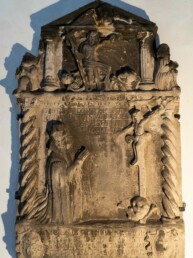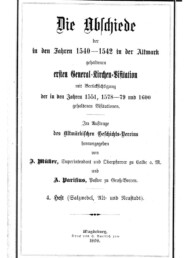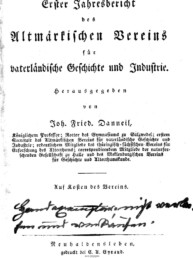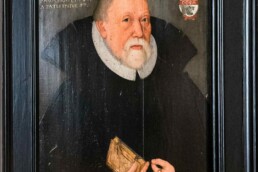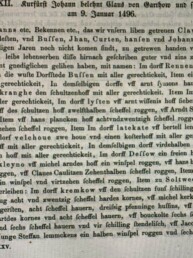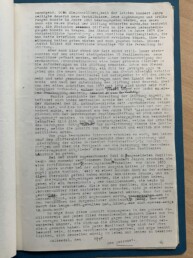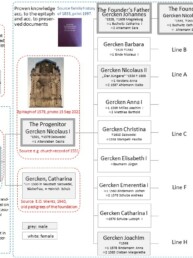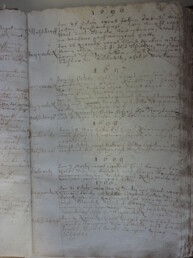The roots of the foundation's progenitor Nicolaus I Gercken, deceased 25.02.1579
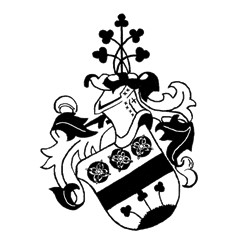
The earliest document known to the Gercken foundation mentioning a Gercken activity describes family members who must have been born as early as about 1440 AD. Documented proof of names and birth dates has been established for dates as early as 1501. This is a rare priviledge. Most pedigrees in Germany start after 1648, as most church records were destroyed in the 30-Years War.
Nicolaus I Gercken, the foundation’s progenitor, was born in 1500 or 1501 (see photo caption above) in Salzwedel. He was also called Clawes (Claus) Gericke (Gerke, Gerken). Around 1525, Nicolaus I married Cecilia Altensleben in Salzwedel. The couple lived in Wollweberstraße. He was mayor of Neustadt Salzwedel and, as a merchant, belonged to the guild of garment tailors. Nicolaus and Cecilia had nine children. Their eldest son was Johannes Gercken (1528 – 1605, see oil painting below), whose only son was Nicolaus III Gercken, the founder of the Gercken family foundation. Both the founder and his only sister, Catharina, died childless. Source: Foundation history published in 1833 under the direction of Johann Friedrich Danneil.
Nicolaus III Gercken (The Founder) initiated the Gercken family foundation through his will of 1607. The will was lost in the Thirty Years’ War (1618-1648). However, copies of (i) the will of 1607 and (ii) the inventory of the estate of 1611 have been preserved. They were handwritten by the notary public of the founder during and shortly after the founder’s lifetime. On 26.2.1654, two sons of the notary public sealed (iii) a certification of the authenticity of (i). (i), (ii) and (iii) are filed in the Salzwedel City Archive and are shown as a photo series on the foundation’s website. The founder was the syndicus of the Magdeburg cathedral chapter. He and his wife died childless. In the spirit of the will, the foundation recognizes all descendants of the founder’s grandfather Nicolaus I Gercken (The progenitor) as family members.
After Martin Luther’s reformation of the Catholic church, all parishes of the Altmark were visited (audited) by the new church authorities between 1540 and 1600 in order to record all property and outstanding debts of tenants and debtors as well as the income from leases and their proper use. A note about the work of Nicolaus I in 1551 is contained in an audit record (photo). “The mayor Claus Gerekens is now in possession of Collecte (money collected from parishioners) COMMENDA CRUCIS to the tune of 200 guilders.”
The ancestors of the progenitor
The names Gerke, Gercken, Gericke, Gerkens, Gerickens are all nicknames derived from the first name Gerhard. Consequently, there are many Gercken families without a proven family link. For example, the famous son of Magdeburg, Otto von Guericke, is not related to the Gerckens of Salzwedel (E.O. Wentz, 1940). In Salzwedel there was a Clawes Gericken (Claus Gercken), who was hospital warden at St. Elisabeth in Salzwedel from 1493 to 1513, but who obviously is not the progenitor and mayor Clawes Gericken (Nicolaus I Gercken). It is unkown whether these two men were related.
Presumably for the first time, on August 16th, 2023, the Gercken Foundation was informed of a source date January 9th, 1496, which mentions a Hofbesitzer (farm owner) named Hans Gerke (Gericke) in Liesten (see reprint on photo). The hint came from the genealogist Frank Moldenhauer from Magdeburg.
Hans (Johannes) Gerke (Gericke, Gercken, Gerken) is presumably the father or uncle of Nicolaus I Gercken, the foundation’s progenitor. He was a merchant in Wollweberstraße in Salzwedel and likely the first of the Gerckens to settle in Salzwedel. The progenitor’s paternal grandfather was possibly named Nicolaus. Nicolaus was a farmer in Liesten. Nicolaus was presumably born around 1440 in Klaeden, near Arendsee.
Acc. to old foundation pedigrees cited by E. O. Wentz in 1940, the progenitor had a sister whose name was Catharina Gercken (Gericke). She was born around 1500 in Neustadt Salzwedel and was married to Heinrich Schulz, who was born around 1500, a baker in Salzwedel’s Wollweberstraße.
In 1940, Ernst Otto Wentz wrote a commissioned treatise entitled “The Family Scholarship Foundation of Syndicus Nicolaus Gercken”, whose publication was precluded by the outbreak of WWII. It was summarized in 1996 by Dr. Roland Jacob et al. in the third update of the foundation’s history published by the patronate in Salzwedel. Wentz writes in his 22-page manuscript (photo) that on some old pedigrees of the foundation archive, a Hans (Johannes) Gericke (Gerke), native of Liesten, a village about 15 km southeast of Salzwedel, is listed as the father of the progenitor. This statement is corroborated by the fact that, according to the custom of his time, Nicolaus I gave his first son the name of his father (i.e. Hans, Johannes (John)). The second son was baptized in the name of his father (Nicolaus). Wentz writes that the 4th patron, Georg II Gercken, sold the property in Wollweberstrasse in 1726, after a quarter of a millennium of the Gerckens’ presence. From this, Wentz concludes that Johannes Gercken (Hans Gericke), the progenitor’s father, was the first of the family to live in Neustadt Salzwedel. The grandfather of the progenitor may have been called Nicolaus Gercken (Gericke, Gerke). It is a mere conjecture based on the inheritance of first names at the time.
Ernst Otto Wentz wrote as early as 1938: “In 1553, Clawes Gericke (the progenitor) had acquired from the Elector (Kurfürst) a fief in the village of Klödens, probably Kläden near Arendsee, together with his brother-in-law Heinrich Schulze and his brother, Magister Paul Schulze, for 200 Rthl. (imperial silver coins)”. Kläden lies a mere 19km distant from Liesten. Furthermore: “Even where the family name does not coincide with the name of a place, the origin can often be traced from the immediate vicinity, as in the case of the Gercken, whose ancestor, the mayor Claus Gercken (the progenitor), still looked after the graves of his ancestors in Clöden (Kläden).” Wentz used the chronology of the Bötcher family (photo) as his source.

